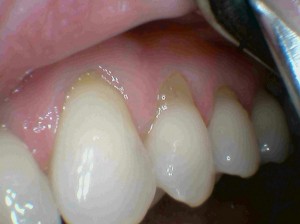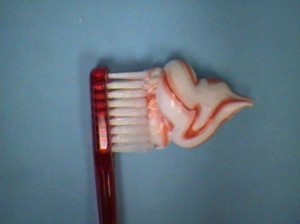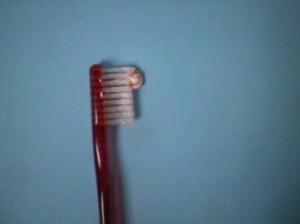How do you clean a bathtub? Normally, you use a hard brush, plenty of elbow grease and a lot of abrasive cleaner. However, that is not how you want to clean your teeth unless you want to wear them away. We discussed the type of tooth brush to use (soft) in our first post and how much force you should use when brushing in our second post.

Gum Recession and Root Surface Abrasion
Why toothpaste matters
This post deals with the type of toothpaste (abrasive cleaner) you use and how much. I used to think the type of toothpaste or how much didn’t matter, but after years of observation and research, I now think it matters. I have come to the conclusion that the abrasiveness of toothpaste can effect the rate of gum recession and tooth structure loss. The abrasiveness of a toothpaste is especially important if you already have recession exposing the softer part of the tooth.
Which tooth paste is best?
Some studies question whether we need to use toothpaste at all. In many studies, dry brushing without paste has been shown more effective at removing bacteria than brushing with toothpaste. So, why do we use toothpaste? It makes our mouths taste better, which, of course, is great marketing by toothpaste companies. So, aren’t all toothpastes pretty much the same? According to each manufacturer, their toothpaste is unique and the best. Our main concern in this blog is the abrasiveness of different tooth pastes and the effect this could have on recession. As you can see from the attached table, the abrasiveness of toothpastes varies widely from 40 to 200. The exact number means little, but a comparison gives us good information. Look your tooth paste up and see where it falls on the scale. My suggestion would be to avoid the highly abrasive toothpastes especially if you have recession or wear. Perhaps, I am being overcautiuos as the American Dental Association sets an upper limit on toothpaste abrasiveness at 250, but it never hurts to be informed. I find it interesting that many of the “whitening” tooth pastes are the most abrasive. The patients who buy these are concerned with their oral hygiene and prone to overzealous brushing to begin with and often unaware that as they wear away their enamel their teeth actually get darker not lighter. They also often present with significant recession.
Toothpaste Abrasiveness Index, Low is better
| 04 Toothbrush with plain water |
91 Aquafresh Sensitive |
| 07 Plain baking soda |
93 Tom’s of Maine |
| 15 Weleda Salt Toothpaste |
94 Rembrandt Plus |
| 30 Elmex Sensitive Plus |
95 Oxyfresh with Fluoride |
| 30 Weleda Plant Tooth Gel |
95 Crest Regular |
| 35 Arm & Hammer Dental Care |
97 Oxyfresh Powder |
| 40 Weleda Children’s Tooth Gel |
101 Natural White |
| 42 Arm & Hammer Mentadent Advance Whitening |
103 Mentadent |
| 44 Squiggle Enamel Saver |
103 Arm & Hammer Sensation |
| 45 Weleda Calendula Toothpaste |
104 Sensodyne Extra Whitening |
| 45 Weleda Pink Toothpaste with Ratanhia |
106 Colgate Platinum |
| 45 Oxyfresh |
106 Arm & Hammer Advance White Extreme Whitening |
| 48 Arm & Hammer Dental Care Sensitive |
107 Crest Sensitivity Protection |
| 49 Tom’s of Maine Sensitive |
110 Colgate Herbal |
| 52 Arm & Hammer Peroxicare Regular |
~80 Amway Glister |
| 53 Rembrandt Original |
113 Aquafresh Whitening |
| 53 Closys |
117 Arm & Hammer Advance White Gel |
| 54 Arm & Hammer Dental Care PM Bold Mint |
117 Arm & Hammer Sensation Tartar Control |
| 57 Tom’s of Maine Childrens |
120 Close Up with Baking Soda |
| 62 Supersmile |
124 Colgate Whitening |
| 63 Rembrandt Mint |
130 Crest Extra Whitening |
| 68 Colgate Regular |
133 Ultra Brite |
| 70 Colgate Total |
144 Crest Multicare Whitening |
| 70 Arm & Hammer Advance White Sensitive |
145 Ultra Brite Advanced Whitening Formula |
| 70 Colgate 2-in-1 Fresh Mint |
150 Pepsodent |
| 78 Biotene |
65 Colgate Tartar Control |
| 79 Sensodyne |
168 Arm & Hammer Dental Care PM Fresh Mint |
| 80 AIM |
176 Nature’s Gate Paste |
| 80 Close Up |
200 Colgate 2-in-1TartarControl/Whitening |
| 82 Under the Gum |
|
| 83 Colgate Sensitive Max Strength |
200 FDA recommended upper limit |
| 87 Nature’s Gate |
250 ADA recommended upper limit |
How much toothpaste should I use?

Tooth paste company ideal
Of course, toothpaste companies want you to use as much paste as possible. They want to sell toothpaste. The classic picture of the toothpaste completely covering the head of the toothbrush is overkill.

Ideal amount of toothpaste
In reality, the toothpaste only needs to be a small amount especially if the major benefit is simply to freshen our mouth. The additional paste is just additional abrasive cleaner and does little to help clean the bacteria off our teeth. The extra abrasive can also result in increased tooth structure loss and recession. Excess toothpaste also produces excess foam and the need to spit, creating a mess. As an aside,the foam producing compound sodium laryl sulfate has been linked to canker sores, so if you are prone to them, avoid toothpastes containing it.
At this point I am not going to get into the controversy about fluoride, I will save that for a later blog. I will simply say I believe fluoride has health benefits for your teeth and that my family uses fluoride containing toothpastes to protect and strengthen our teeth. The paste does make our mouth taste cleaner but has very little additional cleaning benefit except the fluoride. The fluoride in tooth paste is antibacterial and remineralizes your teeth. You could get the same effect by simply using a fluoride mouth wash. Perhaps, someone with no recession or roots exposed can use any toothpaste they want, but when I see a patient who already has recession, I do think it matters because the soft part of the tooth, the root is exposed.



